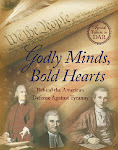Children listen to its stories with wonder and delight, and wise men ponder them as parables of life. The wicked and proud tremble at its warnings, but to the wounded and penitent it has a mother's voice. It has woven itself into our dearest dreams; so that love, friendship, sympathy, devotion, memory, hope, put on the beautiful garments of its treasured speech. No man is poor or desolate who has this treasure for his own.
When the landscape darkens, and the trembling pilgrim comes to the Valley named of the Shadow, he is not afraid to enter; he takes the rod and staff of Scripture in his hand; he says to friend and comrade, 'Goodbye; we shall meet again;', and, confronted by that support, he goes toward the lonely pass as one who walks through darkness into light. Henry Van Dyke
From Our American Forefathers: He who made all men hath made the truths necessary to human happiness obvious to all… Our forefathers opened the Bible to all. Samuel Adams "American Independence," August 1, 1776. Speech delivered at the State House in Philadelphia]
It is impossible to rightly govern the world without God and Bible.
George Washington
The Bible is worth all other books which have ever been printed.
Patrick Henry
I have examined all religions, as well as my narrow sphere, my straightened means, and my busy life, would allow; and the result is that the Bible is the best Book in the world. It contains more philosophy than all the libraries I have seen. John Adams, December 25, 1813 letter to Thomas Jefferson
For more quotes from our Founders, click here.
History:
After the death of Solomon and the division of Israel, the Scriptures were suppressed by many of the inferior kings. It was King Josiah (II Kings) who lead his people in a revival and made known the Scriptures which he read to them in the temple.
The scrolls he read from were carried away and survived their seventy years of captivity in Babylon.
When the Jewish exiles returned to their land in 536 BC, Ezra, the priest/scribe, gathered together all scrolls he could find and made them into one complete work. Most Bible scholars persuade that Ezra, motivated by the direction of God, made additions and updates to the scrolls as he worked on connecting them into one edition. He divided the one complete work into three sections: the Torah, the Prophets, and the Holy Writings.
The Jews combined several related books--such as I and II Samuel into Samuel, I and II Kings into Kings, and I and II Chronicles into Chronicles. They also joined Judges and Ruth, Ezra and Nehemiah, Jeremiah and Lamentations, and the twelve Minor Prophets.
Apparently, the Jews combined these books to reduce the number of scrolls in the Hebrew scriptures to twenty two, which is also the number of letters in the Hebrew alphabet.
Although the number of books in our Old Testament and their arrangement today has changed from ancient times, the text itself has not changed...not one letter, not one jot or tittle... from the Hebrew Bible.
How the books got divided into Chapters: "About A.D. 1248 Cardinal Hugo de Santo Care, while preparing an index to the whole Bible, divided it into its present chapters, subdividing these into several parts by placing the letters A, B, C, D etc. in the margin at equal distances from each other. These divisions were later introduced into many printed editions such as Stephens' Greek New Testament of 1550, still without verse numbers.
Cardinal Hugo's divisions were used in many manuscript copies of the Latin Vulgate, and gradually found a place also in later Greek manuscripts written in Western Europe, and in the earliest printed and all later editions of the Greek New Testament.
Verses: The divisions made by Hugo with the letters of the alphabet, and those adopted by Pagninus in his Latin Bible of 1528, were inconveniently large, and Robert Estienne (better known to us as Stephens) introduced a system of numbered verse divisions in his Greek New Testament published at Geneva in 1551. For this he used as his model the short verses into which the Hebrew Bible had been divided by Rabbi Nathan in 1508, first printed in Venice in 1524. Henry Stephens, Robert's father, had introduced verse numbers in his 1509 edition of the Psalms." For more information write to:
Trinitarian Bible Society
Tyndale House, Dorset Road
London, SW19 3NN, England
Telephone: 0 181 543 7857








































































No comments:
Post a Comment